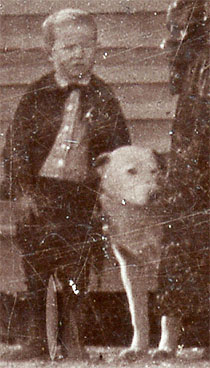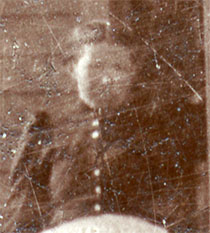Clues
- Photographic process - outdoor photograph
- Woman's and girls' dresses
A cabinet card of this size with such a large scene requires a high resolution scan to reveal all the valuable detail. This was scanned at 600 DPI and 1200 DPI. When the 600DPI scan was zoomed in using Photoshop, all the needed detail was available for a good analysis. The 1200DPI version will be used for restoration: eliminating the wear and tear.
Also enlarging the picture allows you to see fun and interesting detail in the image, even the curious expression on the dog. While there is no markings that indicate the location, the plains states from northern Texas to the Dakotas would have looked much like this. Nearly flat, with no trees for as far as the eye could see. This was native grassland, which the millions of buffalo kept trimmed very close for thousands of years.
Photographic Process
The hue or color of the photograph is different than many cabinet cards - it is NOT a sepia tone, or yellowish. Nearly all paper photographs from the 1860s to the very late 1880s had a yellow-cast to them: usually referred to as sepia. This was a result of the chemical makeup of the underlying material, which was albumen. It yellowed over time.
In the late 1880s, a new underlying base was introduced that would not yellow. This is referred to as collodion. It also produced a variety of different tones, including a dark purple, sometimes bluish, or rich grays. But never a yellow tint. At the same time as the new bases, a faster 'film' process was introduced which allowed outdoor pictures to be taken with greater clarity. Immediately everyone wanted pictures of their homes, farms, animals, and of course families. This allowed the person to show his 'wealth' to others far away.
Outdoor pictures became very popular in the 1890s, with even larger ones produced (see image from January 23, 2012)
Woman and Girls' Clothes
The dresses were probably homemade from a purchased pattern. The two older girls dresses are from the same material, and the two smaller girls are the same but from a different material than the older girls.
These dresses, or at least their style, are very easily dated. Notice the pointed or raised shoulders. These came into popularity in late 1889. The sleeves are slightly loose, indicating late 1890 or more, but they have not reach the bulbous proportions of the mid 1890s. Of course the the large 'leg-o' mutton' sleeves would not have been practical on the farm. But these dresses were probably not everyday dress, only for special occasions. They all dressed up for the picture.
|
 |
While this image does not contribute to dating, this author always loves a boy and his dog. |

Pointed shoulders of woman's dress were popular in the early 1890s. |